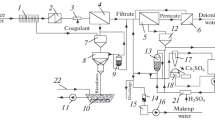Abstract
Technologies for utilizing the wastewater of the reverse-osmosis plants (ROPs) to prepare the make-up water for power-generating plants of combined heat and power plants and nuclear power plants are proposed and substantiated using mathematical models and full-scale experiments. The ROPs use natural feedwater with a wide range of quality characteristics. For the first time, variants of the treatment of the concentrate formed in the ROP cycle have been proposed for the reuse of the latter by acidifying it in H-type cation- exchange filters charged with a weakly acidic cation-exchange resin. By admixing part of the filtrate processed in the H-type cation-exchange filters to the feedwater, the latter is acidified thus reducing the probability of formation of carbonaceous sediments and water consumption. The rest of the filtrate subjected to a conversion process is used as a constituent of the make-up feedwater of the heating system or potable water, which eliminates the discharge of the reverse-osmosis plant wastewater into the environment. Another feature of the proposed technology is that the H-type cation-exchange filters are integrated into a regenerant solution reuse circuit (RSRC). As a result, the consumption rate of sulfuric acid for regeneration equals the stoichiometric rate and the regeneration yields gypsum used to produce a binding agent for construction. The kinetics of separation of gypsum from the spent regenerant solutions with different chemical compositions was studied experimentally as applied to the RSRC conditions. The procedure of operating filters charged with the Lewatit CNP-LF cation-exchange resin was trialed under production conditions. It was established that the height of the filtering cation-exchange resin layer should be 1.0–1.5 m and the concentration of the regenerant solution should not exceed 0.8% at a rate of 10–15 m/h. The basic components of the technological scheme were trialed under production conditions on a water treatment plant in service.
Similar content being viewed by others
References
A. P. Mamet, V. A. Taratuta, and E. B. Yurchevskii, “Principles for the creation of low-waste water treatment units,” Teploenergetika, No. 7, 2–5 (1992).
B. M. Larin, E. N. Bushuev, A. B. Larin, E. A. Karpychev, and A. V. Zhadan, “Improvement of water treatment at thermal power plants,” Therm. Eng. 62, 286–292 (2015). doi 10.1134/S0040601515020056
E. B. Yurchevskii, N. V. Sharyi, A. G. Pervov, and M. A. Pichugina, “Ion exchange and reverse osmosis water demineralization technologies for thermal and nuclear power plants,” Tyazh. Mashinostr., No. 7–8, 10–23 (2015).
V. V. Solodyannikov, Calculation and Mathematical Modeling of Water Treatment Processes (Energoatomizdat, Moscow, 2003) [in Russian].
RD 34.37.504-83. Standards for the Quality of Feed and Network Water of Heating Networks (Soyuztekhenergo, Moscow, 1981).
SanPiN 2.1.4.559-96. Potable Water. Hygienic Requirements to Water Quality in Centralized Potable Water Systems. Quality Control (Goskomsanepidemnadzor, Moscow, 1996).
GOST 20255.2-89. Ion-Exchange Resins. Methods of Determining Dynamic Ion-Exchange Capacity (Standartinform, Moscow, 2002).
Author information
Authors and Affiliations
Corresponding author
Additional information
Original Russian Text © E.B. Yurchevskii, V.V. Solodyannikov, 2018, published in Teploenergetika.
Rights and permissions
About this article
Cite this article
Yurchevskii, E.B., Solodyannikov, V.V. Computational–Experimental Verification of Technologies of Utilization of the Concentrate Formed in the Reverse-Osmosis Water Demineralization Cycle. Therm. Eng. 65, 487–492 (2018). https://doi.org/10.1134/S0040601518070091
Received:
Accepted:
Published:
Issue Date:
DOI: https://doi.org/10.1134/S0040601518070091




